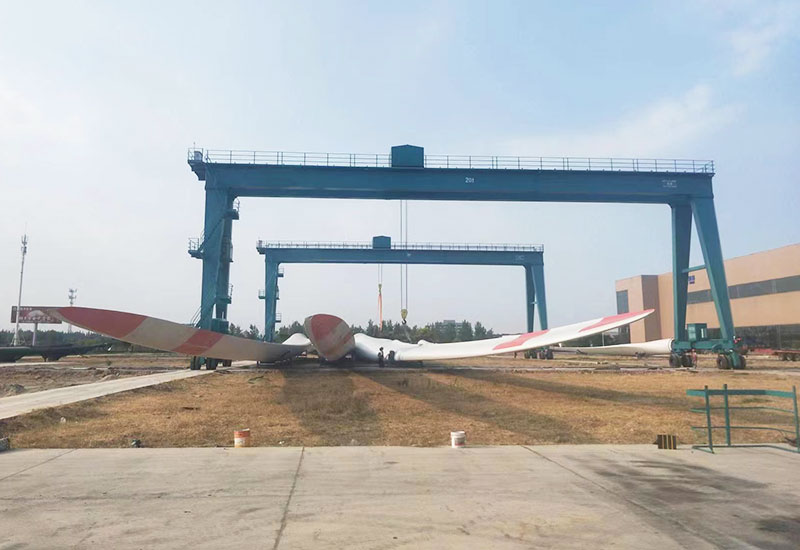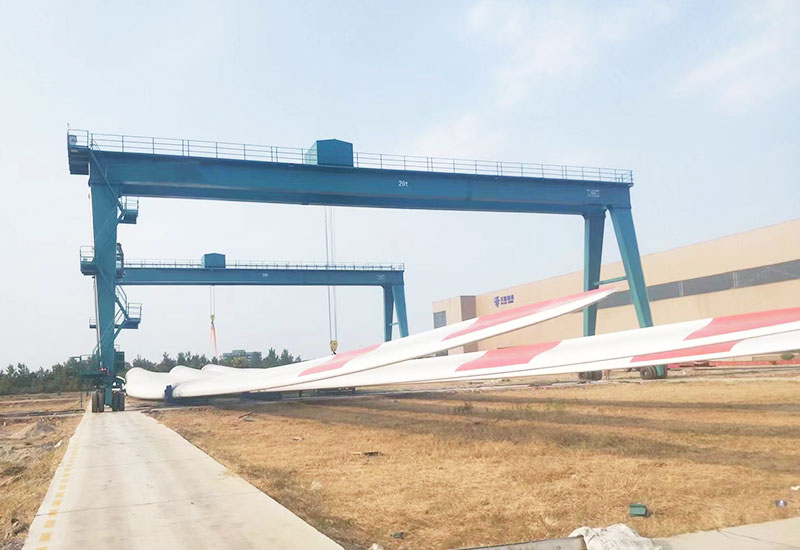Handling wind turbine blades is one of the most challenging tasks in the wind energy industry. These blades are enormous, often exceeding 50 meters in length, and they require specialized equipment for safe, efficient, and damage-free handling during manufacturing, transport, assembly, and maintenance. Among various types of cranes and lifting equipment, the Rubber Tyred Gantry (RTG) crane stands out as a versatile solution for many heavy lifting and container handling tasks. But is an RTG crane truly ideal for wind turbine blade handling? This article explores the features, advantages, challenges, and suitability of rubber tyred gantry cranes for this demanding application.

Understanding Rubber Tyred Gantry Cranes
Rubber Tyred Gantry cranes are mobile, wheeled cranes typically used in container terminals, shipyards, and large logistics hubs for lifting and stacking containers. The defining feature of rubber tyred gantry rtg cranes is their mobility on rubber tires rather than rails, which allows them to move freely across paved surfaces. They typically have a high lifting capacity, ranging from 30 to over 100 tons, and a span wide enough to straddle multiple lanes or rows of containers.
RTG cranes use a double girder or single girder design with a trolley and hoist system to lift heavy loads. Their mobility, flexibility in movement, and relatively fast operation make them popular in logistics industries. However, wind turbine blade handling involves unique requirements that differ from standard container operations.
The Specific Challenges of Wind Turbine Blade Handling
Size and Shape
Wind turbine blades are exceptionally long and slender. Modern blades can reach lengths of 50 to 80 meters and weigh several tons. Their aerodynamic and delicate fiberglass or composite structure demands gentle handling to avoid damage such as cracks or deformation. Unlike containers, blades are not box-shaped but have irregular, tapered profiles.
Handling Safety and Stability
The extended length of blades means handling involves significant moments and leverage forces, which can destabilize cranes or require special rigging equipment. Safety is paramount because blade damage can lead to costly repairs or performance losses, and the blades must be handled in a way that minimizes stress.
Transport and Maneuverability
Blades are typically transported on specialized trailers and require cranes to lift and place them on these trailers or in storage areas. The handling process often occurs outdoors on large yards, demanding equipment that can maneuver easily around obstacles and within limited space.

Advantages of Using RTG Cranes for Wind Turbine Blade Handling
Mobility and Flexibility
One of the biggest advantages of RTG cranes is their rubber-tyred mobility. Unlike rail mounted gantry cranes, RTGs can travel across paved surfaces without the need for tracks, offering flexibility in positioning and adapting to yard layouts. This is especially beneficial in wind turbine blade yards where space may be irregular and cranes must move blades from production lines to storage or loading zones.
High Lifting Capacity and Span
RTG cranes are designed to lift heavy loads and span wide areas. This means they can handle the significant weight and length of turbine blades by spanning multiple lanes or sections. Their lifting height and outreach capabilities also allow them to lift blades onto tall trailers or stack blades in storage racks.
Reduced Infrastructure Costs
Because RTGs operate on rubber tires, they do not require the costly installation of rails or other fixed infrastructure. This can reduce the overall cost of setting up a blade handling facility, especially in remote wind farm construction sites or temporary yards.
Adaptability to Different Load Types
Though designed for containers, RTG cranes can be adapted with specialized lifting attachments such as spreader beams, clamps, or soft slings suited for handling irregularly shaped loads like blades. Their robust design and control systems allow precise movements that are critical for safe blade handling.
Limitations and Challenges of RTG Cranes in Blade Handling
Blade Length vs. Crane Span
While RTG cranes have large spans, wind turbine blades can exceed the span width of many standard RTGs. This can complicate lifting if the blade length cannot be fully supported, requiring additional support or multi-crane lifts.
Handling Precision and Control
Wind turbine blades require delicate handling to avoid damage. RTG mobile gantry cranes, designed primarily for container stacking, may not have the same level of fine control or anti-sway technology that specialized blade handling cranes possess. This could increase risk during delicate operations.
Ground Surface Requirements
Though RTGs can move on rubber tires, they require firm, flat, and paved surfaces to operate safely. Some wind farm assembly sites or blade manufacturing yards may have uneven or soft ground conditions unsuitable for RTGs without additional ground preparation.
Cost and Availability
RTG cranes are capital-intensive equipment often employed in container terminals. Their availability for wind turbine blade projects may be limited, and rental or purchase costs could be higher compared to specialized or lighter lifting equipment designed specifically for blades.
Alternative Equipment Considerations
Other types of cranes and lifting equipment commonly used in wind turbine blade handling include:
-
Overhead Gantry Cranes: Often installed indoors in blade manufacturing plants for controlled and precise handling.
-
Mobile Hydraulic Cranes: Provide flexibility on-site with specialized rigging but can be slower and require more setup.
-
Straddle Carriers and Reach Stackers: Useful for moving blades short distances but less ideal for lifting.
-
Custom Blade Handling Cranes: Designed specifically with soft sling lifts, anti-sway systems, and tailored spans for blades.
Case Studies and Industry Practices
Some blade manufacturers and logistics companies have integrated RTG cranes into their handling process, often customizing the crane with special lifting gear to accommodate blade length and delicacy. For example, by installing spreader bars and soft sling systems, RTGs have been successfully used to lift and stack blades in outdoor storage yards.
However, these adaptations often require additional engineering input and operator training to ensure safe handling. In many wind turbine production sites, a combination of RTG cranes for transport yard operations and overhead gantry cranes for indoor precision handling is common.
Conclusion: Is a Rubber Tyred Gantry Crane Ideal?
The answer depends largely on the specific context of the wind turbine blade handling operation.
-
For Outdoor Yard Handling and Transport Loading: RTG cranes offer excellent mobility, high capacity, and flexibility, making them a strong candidate for moving and stacking large blades in storage or loading them onto transport trailers—provided the yard is well-paved and the crane span accommodates the blade length or supplementary supports are used.
-
For Indoor Manufacturing and Precise Handling: Overhead gantry cranes or specialized blade handling cranes with fine control and anti-sway features are usually better suited.
-
For Sites with Soft or Uneven Terrain: RTG cranes may face mobility challenges and require ground improvements or alternative equipment.
-
For Projects Prioritizing Cost and Availability: RTG cranes may be more expensive and less accessible compared to mobile cranes or custom blade handlers, unless the operation already has container handling infrastructure.
In summary, a rubber tyred gantry crane can be an ideal choice for wind turbine blade handling in the right circumstances, particularly for large outdoor yards with appropriate infrastructure and when equipped with the correct lifting attachments and controls. Careful planning, site evaluation, and possible equipment customization are essential to maximize the RTG crane’s benefits while mitigating its limitations.